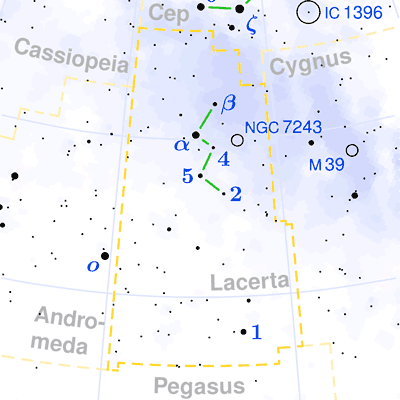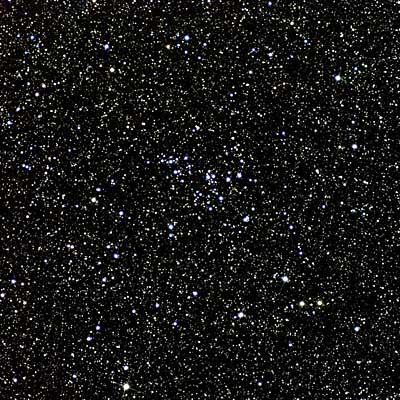Pronunciation:
(luh-SER-tuh)Abbreviation:
LacGenitive:
LacertaeRight Ascension:
22 hoursDeclination:
45 degreesArea in Square Degrees:
201Crosses Meridian:
9 PM, October 10Visible Between Latitudes:
90 and -35 degreesThe constellation Lacerta, the lizard, is located in the northern hemisphere of the sky. It is visible between latitudes of 90 degrees and -40 degrees. It is a very small constellation, occupying only 201 square degrees of the sky. It ranks 68th in size among the 88 constellations in the night sky. It extends from the head of Cepheus to the foot of Perseus, between Cygnus and Andromeda. Lacerta’s brightest stars form a small W in the sky, similar to the constellation Cassiopeia. Because of this, it is sometimes referred to as “Little Cassiopeia.”
The name Lacerta is Latin for "lizard". There is no mythology associated with this constellation. It is one of seven constellations created by the Polish astronomer Johannes Hevelius in the 17th century. It was first introduced in a star atlas published by Hevelius in 1690. It was originally given the name Stellio after a type of lizard known as a stellion, but the name was later changed to Lacerta.

points of interest below © Sea and Sky

© Torsten Bronger CC BY-SA 3.0
Beta Lacertae
1 Lacertae
5 Lacertae
2 Lacertae
4 Lacertae
N/A
N/A
N/A
N/A
N/A
Yellow Giant Star
Orange Giant Star
Binary Star System
Blue-White Dwarf Star
Blue-White Supergiant Star
4.40
4.15
4.37
4.57
4.60
Lacerta is a relatively insignificant constellation composed mainly of dim stars. The brightest star in the constellation has a visual magnitude of only 3.76. Known as Alpha Lacertae, it is a blue subgiant star located about 102 light years from earth. The second brightest star is Beta Lacertae with a magnitude of 4.4. It is a yellow giant star that lies approximately 170 light years away. The third brightest star is 1 Lacertae with a magnitude of 4.15. It is an orange giant star located some 620 light years from our solar system.
Lacerta contains no Messier objects and only a few dim deep-sky objects that can only be seen in very large telescopes. The most notable of these objects is NGC 7243, an open cluster of stars located approximately 2,800 light-years from Earth. This young cluster consists mainly of white and blue stars and is thought to be about 100 million years old.

© Egres73 / CC BY 3.0



